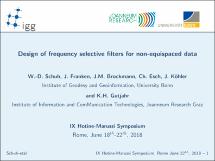Design of frequency selective filters for non-equispaced data

Design of frequency selective filters for non-equispaced data

| dc.contributor.author | Schuh, Wolf-Dieter | |
| dc.contributor.author | Franken, Jessica | |
| dc.contributor.author | Brockmann, Jan Martin | |
| dc.contributor.author | Esch, Christina | |
| dc.contributor.author | Köhler, Joël | |
| dc.contributor.author | Gutjahr, Karlheinz | |
| dc.date.accessioned | 2022-06-24T14:44:38Z | |
| dc.date.available | 2022-06-24T14:44:38Z | |
| dc.date.issued | 22.07.2018 | |
| dc.identifier.uri | https://hdl.handle.net/20.500.11811/9951 | |
| dc.description.abstract | Modern sensors and satellite missions deliver huge data sets and long time series of observations. In the most cases equispaced time series are collected. Filtering of time series is a standard task in data analysis. Therefore a large variety of methods is already established to deal with equispaced time series. Discrete digital filters can be individually designed in the time as well as in the frequency domain. Often a priori information in the frequency domain is used to extract the signal of interest from the remaining part. These well established strategies presume equispaced samples to get access to the frequency domain behaviour. In this article we focus our attention on non-equispaced time series, which often appear in satellite geodesy and remote sensing. Again we assume that a special behaviour in the frequency domain characterizes the desired part of the signal. To extract exactly this part of the signal we construct frequency limited base functions, which are able to provide a strict cut-off in the frequency domain. A linear combination of these base functions can be applied in an approximation procedure. Thus, it is possible to extract the desired band-limited signal also for non-equispaced data sets. Our article is focused on the construction of these frequency limited base functions. Starting with piecewise given polynomial base functions with finite support (Splines), we construct by the inversion of an infinite band Toeplitz system tailored base functions, which are mutually independent (sampling splines). These sampling splines can be transformed into the spectral domain and because of the finite support of the original base functions a closed form representation in the spectral domain is possible (finite sums). Detailed studies on the filter characteristic in the frequency domain allows then a simple access to design low pass filters for non-equispaced data with a predefined passband region. It can be seen that the order of the splines controls the transition width as well as the stopband attenuation. Some practical examples demonstrate the capability of this approach in practice. | en |
| dc.format.extent | 43 | |
| dc.language.iso | eng | |
| dc.rights | Namensnennung - Nicht kommerziell - Keine Bearbeitungen 4.0 International | |
| dc.rights.uri | http://creativecommons.org/licenses/by-nc-nd/4.0/ | |
| dc.subject | filtering in space-domain, splines, cardinal splines | |
| dc.subject.ddc | 526.1 Geodäsie | |
| dc.title | Design of frequency selective filters for non-equispaced data | |
| dc.type | Konferenzveröffentlichung | |
| dc.identifier.doi | https://doi.org/10.48565/bonndoc-43 | |
| dc.publisher.name | Institute of Geodesy and Geoinformation, Theoretical Geodesy Group, University of Bonn | |
| dc.publisher.location | Bonn | |
| dc.rights.accessRights | openAccess | |
| ulbbn.pubtype | Zweitveröffentlichung | |
| ulbbn.relation.conference | The IX Hotine-Marussi Symposium, 18th - 22th June 2018, Rome |
Files in this item
This item appears in the following Collection(s)
-
Talks (6)




